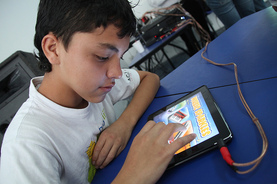Socially Accessible:
Helping Parents - Help Children - Help Our CommunityYou will need to sign up for a free edweb.net account to view the linked webinars.
In this issue: Autism Characterisics, Working with Families Facing ASD, Accessible Documents
In this issue: Autism Characterisics, Working with Families Facing ASD, Accessible Documents
|
Children/students who have been diagnosed with Autism, now recognized as Autism Spectrum Disorder (ASD), may display a wide variety of language and social characteristics that might be considered unusual for children of the same chronological age. I attended the webinar Communication Characteristics of Autism available from EdWeb.net and presented by Diane VanDriesen that discussed these characteristics and the implications for students in classroom and home settings.
In the full article, learn about some of the characteristics of Autism that teachers and parents need to consider in lesson planning and communications - even when practicing Universal Design for Learning. |
Working With FamiliesWorking with Families of Children with AutismLink to WebinarThe webinar Working with Families of Students with Autism, presented by Nina Finkler, in addition to my personal experience of being the parent of a child with a diagnosis, helped me to appreciate the difficulties mainstream teachers may have working with families with special needs. Even Assistive Technologies may present difficulties rather than overcome obstacles.
In some cases parents are dealing with grief over a diagnosis, financial difficulty, exposure to overwhelming or inaccurate information, or even their own visible or invisible disabilities. This article discusses traits of families dealing with Autism Spectrum Disorder and what we can do as teachers to build positive relationships. Read this article now! |
I had the experience of participating in a webinar on Creating Accessible Documents in Word, Excel, and PowerPoint. While a host of unexpected technical issues ensued, the information and the chat feature were enlightening experiences. Like many others, I occasionally used the headers or styles in Microsoft Word to make documents attractive and to visually support the structure of documents in addition to bulleted lists, I had never considered the needs of those with screen readers or vision impairments or other Assistive Technologies who are entitled to the same access to electronic documents as the rest of my audience.
Want to increase the effectiveness of your communication? Read the article on Creating Accessible Documents!
Want to increase the effectiveness of your communication? Read the article on Creating Accessible Documents!





